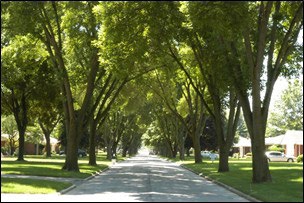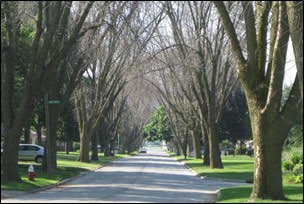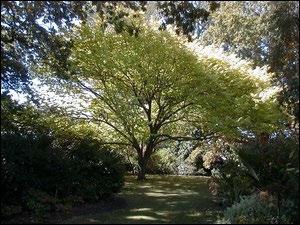PESTS AND DISEASES OF FORESTRY IN NEW ZEALAND
Recognising Benefits, Costs and Risks Associated to Urban Trees
Scion is the leading provider of forest-related knowledge in New Zealand
Formerly known as the Forest Research Institute, Scion has been a leader in research relating to forest health for over 50 years. The Rotorua-based Crown Research Institute continues to provide science that will protect all forests from damage caused by insect pests, pathogens and weeds. The information presented below arises from these research activities.
From Forest Health News 270, December 2016.
Trees in urban landscapes provide a range of economic, social and environmental benefits (ecosystem services), and these are increasingly recognized by cities and municipalities worldwide. Trees mitigate soil erosion, and moderate climate, reduce noise and air pollution. They also increase aesthetic value and support wildlife diversity, act as natural stress relievers and contribute to higher property prices. For biosecurity purposes (i.e. to decide on whether to attempt eradication of organisms at risk for trees) the benefits provided by trees and their associated costs and liabilities need to be quantified.
In California, one of the largest studies to date has compiled data from 50 cities to estimate the annual value of all ecosystem services provided by the State’s 9 million street trees at US$ 1.0 billion (McPherson et al., 2016). This corresponds to US$110 per tree, and exceeds by far the average annual management cost of US$19 per tree. The long term value of Californian street trees has been estimated to be approximately US$2700 per tree.


Putting dollar values on municipal trees, considering their benefits as well as their cost of maintenance or replacement, can be used to inform management of both current trees and new plantings. In Brisbane, more than 400,000 street trees are currently managed by the City Council. Their associated costs have been evaluated (Plant and Sipe, 2016), showing most trees require no or low maintenance (87%), while 11% require medium maintenance, and only one percent require major work or removal. In Brisbane, about 11,000 trees are planted every year and this aligns very well with Australia’s 2020 Vision campaign to increase tree planting in urban green spaces by more than 20% (Horticulture Innovation Australia, 2015). There is also a trend in increased planting of urban trees in New Zealand. In Wellington City, one million trees have been planted in the last decade and the City Council has aimed to double that number by 2020 (Wellington City Council, 2016).

In quantifying the cost and benefits of urban trees from an economic perspective, a variety of hidden costs are usually not accounted for. These include detrimental effects caused by the trees, such as damages to physical structures, risks to public safety, or the accidental provision of habitats for unwanted invasive species (ecological disservices). Urban trees can be affected by a number of threats relating to increased urbanization and global change, with biological invasions being arguably the most near-term menace to consider.
From past examples, we know introductions of insects and pathogens have occasionally caused the near elimination of entire tree species from very large regions in just a couple of decades. In the early 1900s, chestnut blight almost wiped out the entire range of American chestnut, and later that century most American elms were killed by Dutch elm disease. More recently, emerald ash borer arrived in North America from Asia, and is thought to be one of the most impactful tree pests to date. It has killed hundreds of millions of ash trees, predicted to cost about US$12.5 billion by 2020, largely due to costs of treatment, removal and replacement in urban landscapes where ash can make up to 20% of the trees (Kovacs et al., 2011).
In New Zealand, a number of damaging insects and pathogens have been introduced into our urban trees. Dutch elm disease is still present in Auckland, but
four economically important moth species have been eradicated from urban areas over the past 20 years.
Certainly not all of these species are highly destructive, but the accumulation of low and moderate impact species can still affect high value trees. Evaluating the structure, function and value of trees, and balancing these with the risks and costs of protecting them from current and future pests and diseases, is therefore worth the effort for the long-term preservation of urban landscapes and the sustainable provision of ecosystem services. The success of protecting both urban and rural forests would depend on our ability to detect significant pests and diseases
in a timely fashion, so that necessary interventions can be undertaken accordingly (including early eradication attempts if needed). In New Zealand, the Forest Owners Association and the Ministry for Primary Industries have recently negotiated a Government Industry Agreement (GIA) to manage the introduction of pests and diseases that could affect the forest industry. There is a need to work in partnership with the industry and the government so that one can better achieve biosecurity surveillance and pest management targets. New Zealand city dwellers and residents as well as councils have recognized the importance of the establishment and maintenance of street and park trees for everyday living (Vesely, 2007). As trees in urban areas are likely to be the first to be adversely impacted by newly introduced pests and diseases, the public will rapidly be the first to realise the benefits from a highly successful national forest biosecurity system and GIA.
References
Horticulture Innovation Australia. 2015. The 202020 Vision Plan. Pages 1–57.
Kovacs, K. F., R. J. Mercader, R. G. Haight, N. W. Siegert, D. G. McCullough, and A. M. Liebhold. 2011. The influence of satellite populations of emerald ash borer on projected economic costs in US communities, 2010-2020. Journal of Environmental Management 92:2170–81.
Plant, L., and N. Sipe. 2016. Adapting and applying evidence gathering techniques for planning and investment in street trees: A case study from Brisbane, Australia. Urban Forestry & Urban Greening 19:79–87.
McPherson, E. G., N. van Doorn, and J. de Goede. 2016. Structure, function and value of street trees in California, USA. Urban Forestry & Urban Greening 17:104–115.
Vesely, E.T. 2007. Green for green: the perceived value of a quantitative change in the urban tree estate of New Zealand. Ecological Economics 63: 605–615.
Wellington City Council. 2016. Two Million Trees. http:// wellington.govt.nz/your-council/projects/two-million- trees
Nicolas Meurisse, Richard Yao and Lindsay Bulman (Scion)
This information is intended for general interest only. It is not intended to be a substitute for specific specialist advice on any matter and should not be relied on for that purpose. Scion will not be liable for any direct, indirect, incidental, special, consequential or exemplary damages, loss of profits, or any other intangible losses that result from using the information provided on this site.
(Scion is the trading name of the New Zealand Forest Research Institute Limited.)



